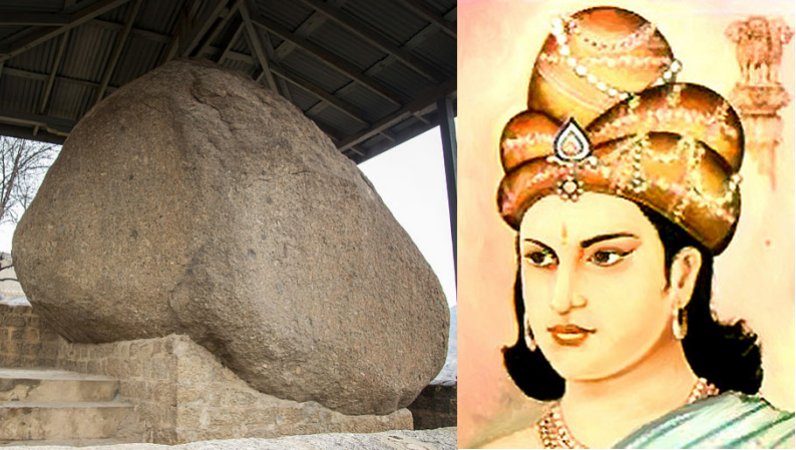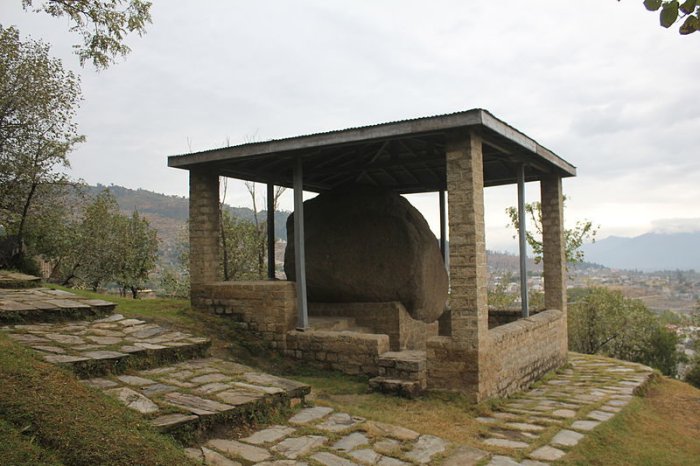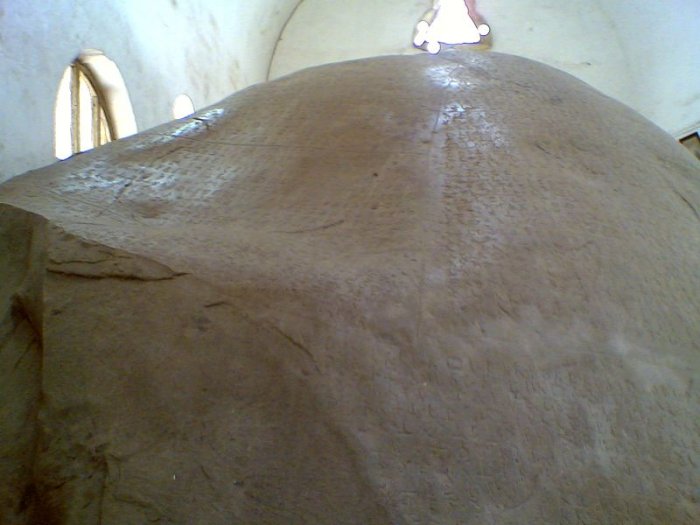Mansehra Rock Edicts – Last Words Of Emperor Ashoka
Ellen Lloyd - AncientPages.com - Emperor Ashoka (304 B.C -232 B.C.) is long gone but this great historical figure left behind an everlasting legacy and he is remembered for his energy, determination, and promotion of Buddhism. Considered one of India's greatest emperors, Ashoka ruled almost all of the Indian subcontinent from 268 to 232 B.C.
Left: The giant rock of Ashoka. Credit: Faysal Elahi, CC BY-SA 4.0 - Right: Artistic impression of Emperor Ashoka. Credit: Pinterest
“From the Volga to Japan his name is still honored. More living men cherish this memory today than have ever heard the names of Constantine or Charlemagne,” H.G. Wells writes in the Outline of History. 1
The early part of his reign was undoubtedly bloodthirsty, but after witnessing the mass deaths of the Kalinga War, Emperor Ashoka changed as a person and converted to Buddhism.
Emperor Ashoka won the Kalinga War, a battle fought between him and the Mauryan army led by King of Raja Anantha, but the price was high. The war took a tremendous toll of life and property. More than 100,000 soldiers were killed, and 150,000 civilians were deported.
One of the major rock edicts with an inscription made by Emperor Ashoka. Credit: Muhammad Zahir, CC BY-SA 3.0
Legend tells that one day after the war had finished, Emperor Ashoka came to the city and he was shocked to see the complete destruction and dead corpses. The horrible scenes of death led to his conversion to Buddhism and he became a more peaceful emperor.
Emperor Ashoka’s last words were preserved for future generations. The Mansehra rock edicts, cut into the surface of three large boulders can be found on a small rocky mountain outside the city of Mansehra in Khyber Pakhtunkhwa province of Pakistan. The edicts date back to the 3rd century B.C. and it is widely believed the text is written in the ancient Indic script of Gandhara culture, Kharosthi.
In the fourth rock edict and three others, scientists found evidence that Emperor Ashoka “wished to remind his subjects of certain religious shows at which he had exhibited to them in effigy the gods whose abodes they would be able to reach by the zealous practice of dhamma.” 2
On the thirteenth edict, Emperor Ashoka expressed his feelings after witnessing the destruction of Kalinga.
According to the translated text, Ashoka felt great remorse for what had happened.
Major Rock Edict contains inscriptions by Ashoka. Credit: Jadia Gaurang, CC BY-SA 3.0
“Directly after the Kalingas had been annexed began His Sacred Majesty’s zealous protection of the Law of Piety, his love of that Law, and his inculcation of that Law. Thence arises the remorse of His Sacred Majesty for having conquered the Kalingas, because the conquest of a country previously unconquered involves the slaughter, death, and carrying away captive of the people. That is a matter of profound sorrow and regret to His Sacred Majesty.” 3
The Mansehra rock edicts are of great historical importance, but due to environmental degradation, the ancient script is fading away and it’s almost impossible to read the message today. Pakistan has tried to cover the rocks with canopies to shelter the boulders from weather conditions. Hopefully, this important historical site can be saved, and the last words of Emperor Ashoka will still be accessible to future generations.
The site has been submitted for inclusion in the UNESCO World Heritage Sites and is currently on the tentative list.
Written by Ellen Lloyd – AncientPages.com
Copyright © AncientPages.com All rights reserved. This material may not be published, broadcast, rewritten or redistributed in whole or part without the express written permission of AncientPages.com
Expand for references- G. Wells – The Outline of History
- Hultzsch, E. "New Readings in Asoka's Rock-Edicts." Journal of the Royal Asiatic Society of Great Britain and Ireland, 1913, 653-55
- Vincent Smith - Asoka: The Buddhist Emperor of India
More From Ancient Pages
-
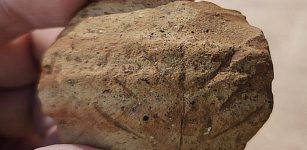 Intriguing Fragment Of A Byzantine-Era Jar Handle, Dating Back Approximately 1500 Years – Unearthed
Archaeology | Sep 5, 2023
Intriguing Fragment Of A Byzantine-Era Jar Handle, Dating Back Approximately 1500 Years – Unearthed
Archaeology | Sep 5, 2023 -
 Walls Of Uruk Built By Sumerian King Gilgamesh 4,500 Years Ago
Featured Stories | Nov 28, 2015
Walls Of Uruk Built By Sumerian King Gilgamesh 4,500 Years Ago
Featured Stories | Nov 28, 2015 -
 Ancient Riddle Solved – Why Was Roman Concrete So Durable?
Archaeology | Jan 7, 2023
Ancient Riddle Solved – Why Was Roman Concrete So Durable?
Archaeology | Jan 7, 2023 -
 Are The Strange Lawrence Brook Carvings In New Jersey A Cryptic Message?
Featured Stories | Feb 10, 2023
Are The Strange Lawrence Brook Carvings In New Jersey A Cryptic Message?
Featured Stories | Feb 10, 2023 -
 Probably The Oldest Star Map Discovered In Stone Chamber Of The Kitora Tomb, Asuka Nara, Japan
Ancient History Facts | Jul 19, 2015
Probably The Oldest Star Map Discovered In Stone Chamber Of The Kitora Tomb, Asuka Nara, Japan
Ancient History Facts | Jul 19, 2015 -
 Mystery Of The Minoan Blue Monkeys Depicted In Frescoes
Archaeology | Apr 16, 2020
Mystery Of The Minoan Blue Monkeys Depicted In Frescoes
Archaeology | Apr 16, 2020 -
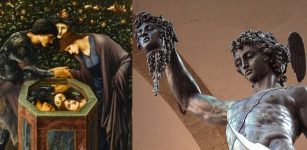 Perseus – Courageous Adventurer Who Fulfilled A Prophecy
Featured Stories | Jul 31, 2018
Perseus – Courageous Adventurer Who Fulfilled A Prophecy
Featured Stories | Jul 31, 2018 -
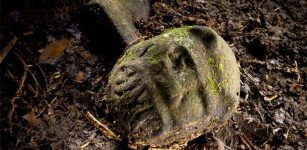 Explorers Of Lost City Of The Monkey God Contract Unusual Flesh-Eating Disease
Archaeology | Jan 22, 2017
Explorers Of Lost City Of The Monkey God Contract Unusual Flesh-Eating Disease
Archaeology | Jan 22, 2017 -
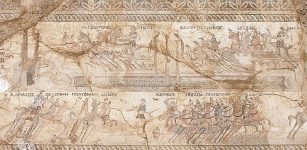 4th Century Mosaic With Hippodrome Scene Excavated At Akaki, Cyprus
Civilizations | Sep 10, 2015
4th Century Mosaic With Hippodrome Scene Excavated At Akaki, Cyprus
Civilizations | Sep 10, 2015 -
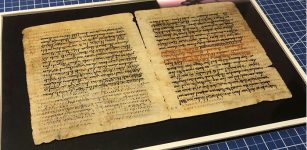 Lost Ancient Texts Of The Star Catalogue Composed By The Greek Astronomer Hipparchus Found
News | Feb 21, 2023
Lost Ancient Texts Of The Star Catalogue Composed By The Greek Astronomer Hipparchus Found
News | Feb 21, 2023 -
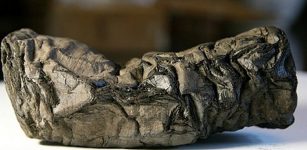 2,000-Year-Old Herculaneum Scrolls Will Be Unwrapped And Deciphered
Archaeology | Oct 8, 2019
2,000-Year-Old Herculaneum Scrolls Will Be Unwrapped And Deciphered
Archaeology | Oct 8, 2019 -
 Advanced Ancient Civilization’s Encounter With Primitive People Led To Something Extraordinary – Thought-Provoking Theory Suggests
Civilizations | Dec 19, 2018
Advanced Ancient Civilization’s Encounter With Primitive People Led To Something Extraordinary – Thought-Provoking Theory Suggests
Civilizations | Dec 19, 2018 -
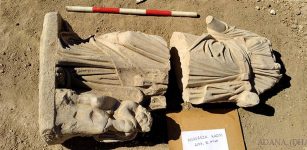 Statue of Goddess Hygieia And Eros Unearthed in Ancient City of Anavarza, Southern Turkey
Archaeology | Dec 7, 2017
Statue of Goddess Hygieia And Eros Unearthed in Ancient City of Anavarza, Southern Turkey
Archaeology | Dec 7, 2017 -
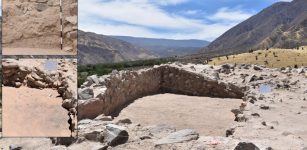 1,200-Year-Old Wari Temple Discovered In Peru
Archaeology | Feb 24, 2023
1,200-Year-Old Wari Temple Discovered In Peru
Archaeology | Feb 24, 2023 -
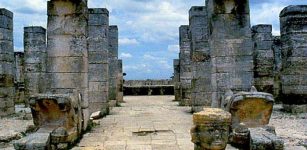 ‘Chac Mool’ – Intriguing Life-Size Figure Carved In Single Stone
Featured Stories | Mar 5, 2016
‘Chac Mool’ – Intriguing Life-Size Figure Carved In Single Stone
Featured Stories | Mar 5, 2016 -
 Nomadic Pasture Farming Was Developed 7,000 Years Ago In Swiss Alps
Archaeology | Apr 13, 2017
Nomadic Pasture Farming Was Developed 7,000 Years Ago In Swiss Alps
Archaeology | Apr 13, 2017 -
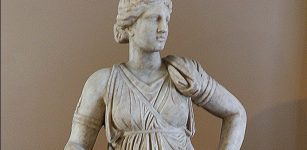 Goddess Artemis – One Of The Most Respected Olympians
Featured Stories | Oct 1, 2016
Goddess Artemis – One Of The Most Respected Olympians
Featured Stories | Oct 1, 2016 -
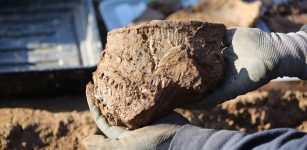 Bronze Age Finding Offer New Clues On The Beginnings Of Cardiff
Archaeology | Jul 15, 2022
Bronze Age Finding Offer New Clues On The Beginnings Of Cardiff
Archaeology | Jul 15, 2022 -
 Ostrich Eggshell Beads Were Social Currency For People Who Lived 33,000 Years Ago
Archaeology | Mar 12, 2020
Ostrich Eggshell Beads Were Social Currency For People Who Lived 33,000 Years Ago
Archaeology | Mar 12, 2020 -
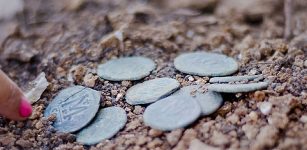 Nine 1,400-Year-Old Coins Belonging To Christian Pilgrims Found On The Highway To Jerusalem
Archaeology | Mar 24, 2017
Nine 1,400-Year-Old Coins Belonging To Christian Pilgrims Found On The Highway To Jerusalem
Archaeology | Mar 24, 2017

